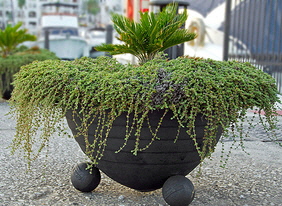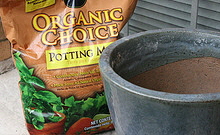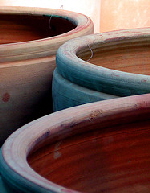Growing Evergreens in Containers
With careful selection of the container, the site, the variety and with proper care you can have your evergreen in a container.
Growing evergreens in containers can be tricky, especially in the cold regions of the North and Midwest. Generally it is best to plant evergreens in the ground, whether conifers or broadleaf. But then as gardeners, we just have to have a conifer up on the deck! Or on the front step or patio. There are a great many places where we would love to have year round green but no soil to accommodate. So we risk it.
Best Container for Evergreens
When selecting containers for evergreens remember that the plant will get much much larger, and evergreens have large root balls and need a lot of soil. So don’t just get what you think is a big container, get what you think is enormous. A few years down the road it will seem too small. Try to use a container at least 2 or 3 times wider than the root ball you will be planting and as deep as you can find. But do remember that even with a potting mix a planted container can get extremely heavy. If you plan to move your container at all make sure you have some extra muscle available. Or invest in a container caddy with wheels.
Make sure your pot has a drainage hole, put a piece of screen or wire mesh over the hole to hold the soil before filling with soil. Always use potting soil in containers, they are specifically mixed to allow moisture retention, good drainage and air pockets for roots to access. Standard garden soil will become over saturated and compact, not to mention very heavy. Adding a little compost may be beneficial, but backyard compost may contain soil organisms or disease that you do not want to introduce to your sterilized potting mix. Purchased compost, not composted manure, would be a better option. Specifically a potting compost is ideal but not easy to find, John Innes No 2 is one example.
Moisten your potting mix as you fill the pot so it is easier to manage.
A white or light colored container will not absorb heat as well as dark colors and will keep the soil and roots from overheating.
Concrete containers are very durable and can be painted.
Wood containers create a natural look and can be painted or stained.
Terra Cotta and Clay containers are porous and provide very good drainage. They can be glazed or painted. However Terra Cotta and clay pots typically will not withstand freezing temperatures. Moisture in the porous material will expand when it freezes, cracking the container. They should be stored in the garage or shed over winter, which your plant may not tolerate.
Best Site for Evergreens in Containers
Avoid placing your potted evergreen in direct sunlight to keep the soil and roots cooler. During the growing season most evergreens need a good deal of sun and morning and late day sun are best, during the hottest part of the day your container and soil may heat up enough to damage roots. In the northernmost regions this is not so much of a problem as in warm regions where midday sun gets very hot.
Containers should be positioned where they are easily accessed for regular maintenance, although you won’t necessarily need your garden hose if you are watering regularly. A large sprinkling can should take care of all but the largest of containers.
Broad leaved evergreens should be positioned in a site that is sheltered from strong or frequent winds as well as midday sun. The foliage is fairly susceptible to drying out.
Caring for Evergreens in Containers
Water regularly, generally a weekly soaking should do it. But containers can dry out very quickly so be sure to monitor the soil by poking your finger deep into the soil to make sure it is moist, especially during periods of excessive heat. In warm regions and periods of excessive heat it may be necessary to water every day. Remember that once you see browning needles you are too late, evergreens do not show their stress quickly.
Feed regularly but be careful not to over feed. There is no “surrounding soil” to absorb excess fertilizer so you could “burn” the roots. But also remember that water running through container soil and out of the container washes nutrients out too, so it is very important to have a regular feeding schedule. Apply one fourth or less of what your fertilizer package recommends. A time release fertilizer makes it easy to apply the right amount and not forget.
Mulch the soil with woodchips or sphagnum moss to help hold soil moisture and to help deflect the sun’s heat.
Evergreens that get very large may need to be re-potted in a larger container or removed from the container and root pruned. When the roots have filled the container there is no longer enough room for soil which holds moisture and nutrients for the plant. This is called root bound, and your plant will cease to grow and begin a slow demise
Overwintering Evergreens in Containers
Plant hardiness is critical when growing an evergreen in a container. In regions where the temperature dips below freezing, the soil in a container will freeze much faster than the soil in the ground. Your plant should be hardy to at least 2 growing zones colder than your region. So in zone 6 plant zone 4 hardy evergreens. Even in zone 4 we can find suitable zone 2 evergreens for containers.
Place a few bricks under your container to elevate the drainage holes, or shim up one side to tilt the container. Once the ground freezes it will not allow moisture to drain out of your pot if it sits flat on the ground or cement.
A larger container lessens the chance of the soil drying out and of winter damage and freeze thaw damage.
Smaller containers can be buried in the garden for protection over the winter. Bury right up to the rim then cover the container soil with mulch.
Position your container out of the wind to prevent drying up the needles. They will turn brown and drop and take a long time to recover.
Potted evergreens should receive some sunlight in winter, but not late day sunlight if possible, and certainly not all day direct sun. Morning or midday sun is best. If the sun is warm enough to warm up your container it will have all day to slowly refreeze. Soil that thaws in late day and the refreeze quickly when the sun goes down may damage roots and may expand enough to heave the plant up in the container.
Soil moisture is important over winter and you need to do what you can considering the weather conditions. If it is excessively dry going into winter make sure you water the container right up until the soil freezes. But do not saturate the soil as the water will expand when it freezes and perhaps heave the plant out of the container.
If you have selected an evergreen that may not be hardy enough to get through winter well in a container, check some of the great ideas for overwintering tender roses in containers: Winterize Container Roses, but be sure to use the tips for storing outside, not in a garage or basement. Evergreens do not go dormant and need sun.


